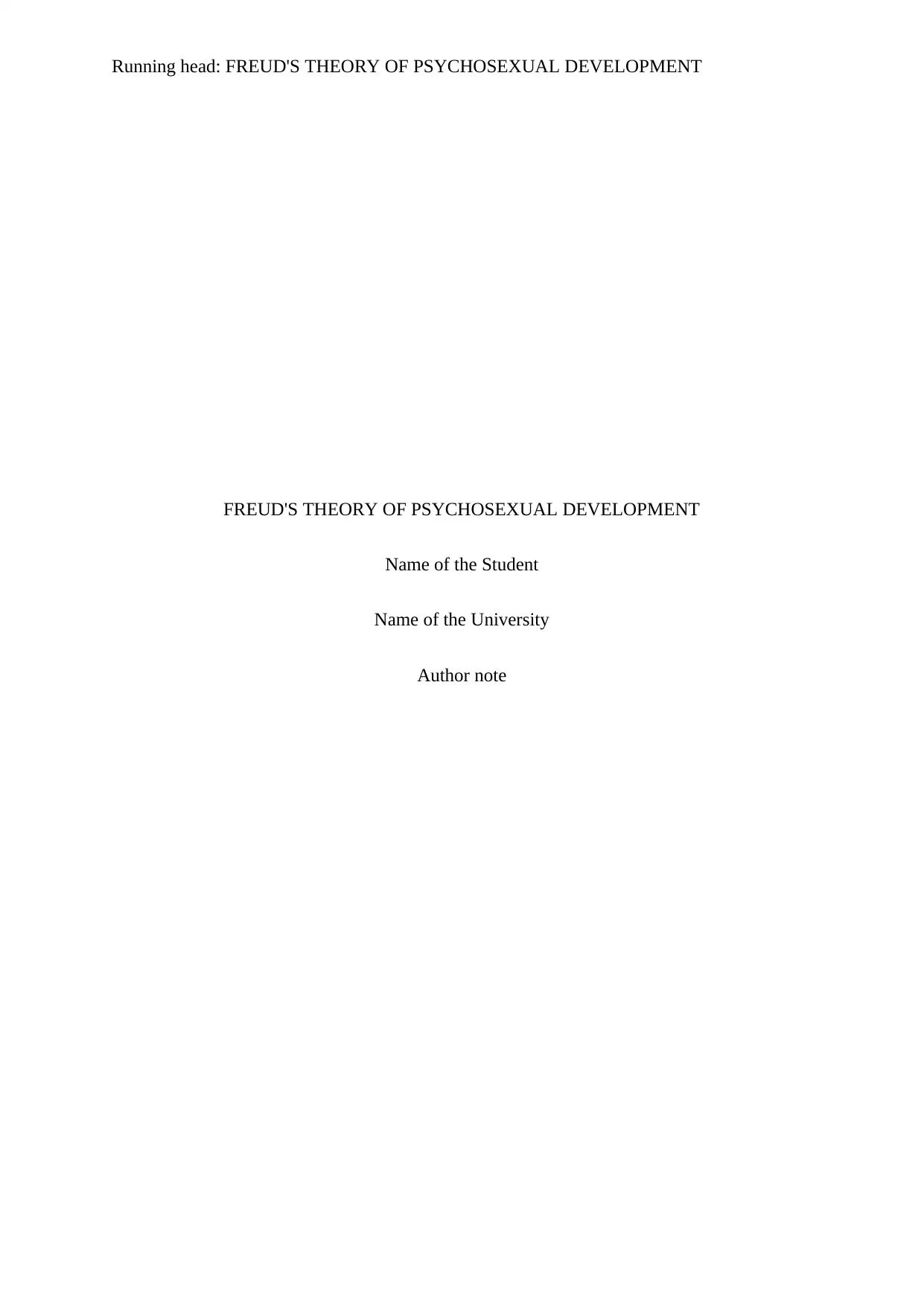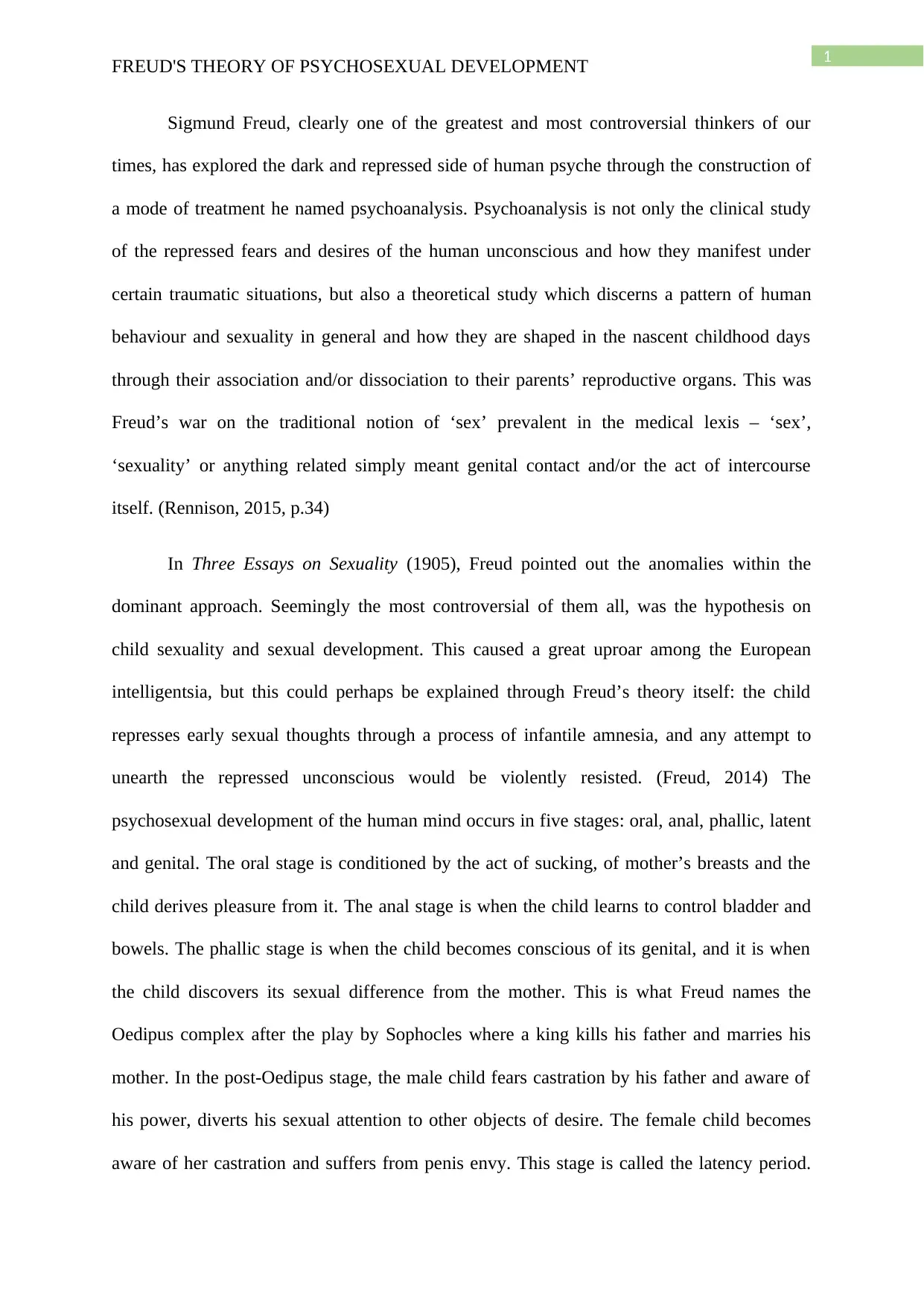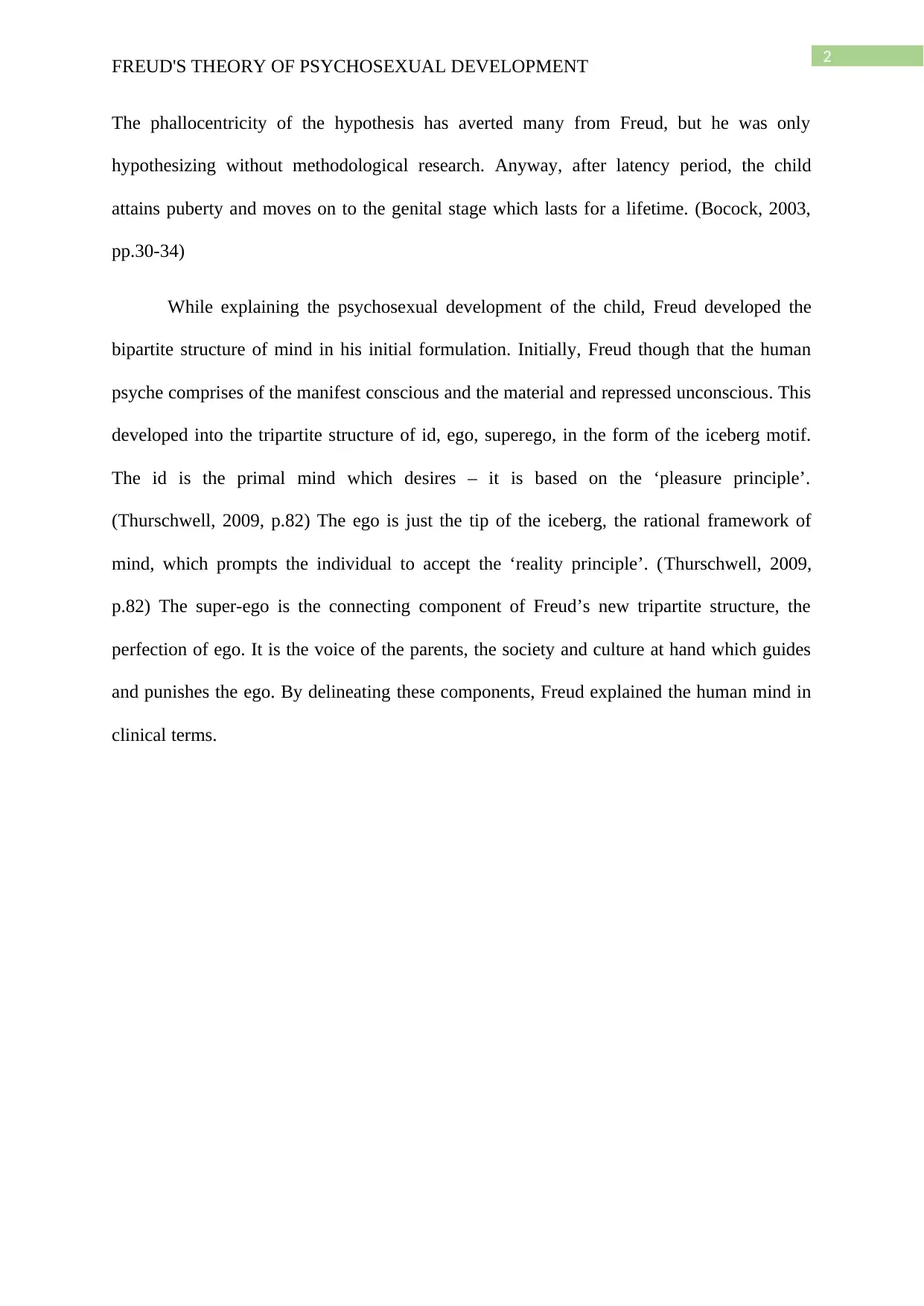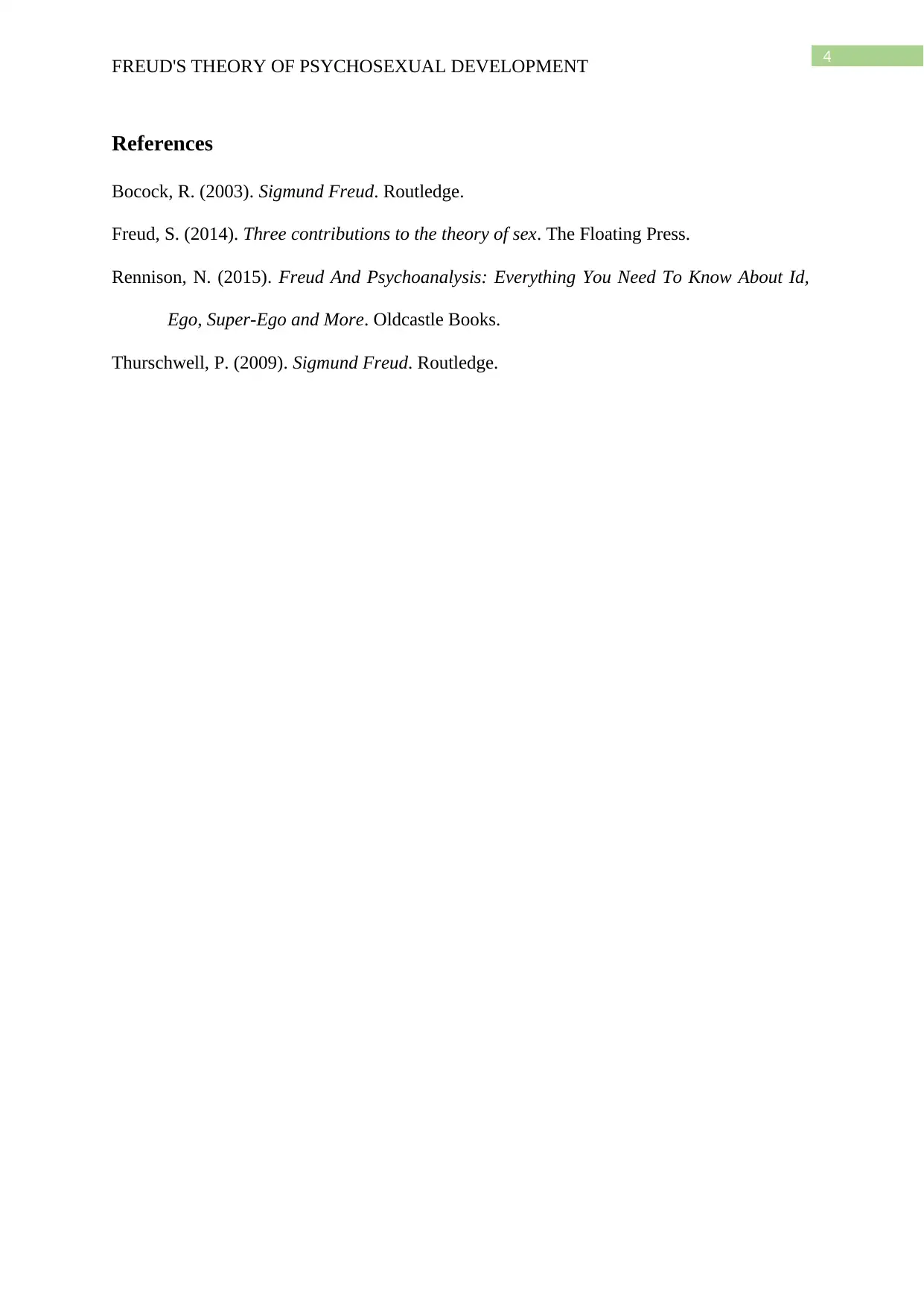A Comprehensive Analysis of Freud's Theory of Psychosexual Development
VerifiedAdded on 2022/11/18
|5
|735
|183
Essay
AI Summary
This essay provides a comprehensive overview of Sigmund Freud's theory of psychosexual development. It details the five stages: oral, anal, phallic, latent, and genital, explaining the key characteristics and developmental tasks of each stage. The essay explores Freud's concepts of the Oedipus complex and penis envy within the phallic stage, highlighting the psychosexual development of the human mind. Furthermore, it delves into Freud's structural model of the mind, including the id, ego, and superego, and their roles in shaping human behavior. The essay references key works such as 'Three Essays on Sexuality' and provides a clear understanding of Freud's contributions to psychoanalysis, offering a valuable resource for students studying psychology.

Running head: FREUD'S THEORY OF PSYCHOSEXUAL DEVELOPMENT
FREUD'S THEORY OF PSYCHOSEXUAL DEVELOPMENT
Name of the Student
Name of the University
Author note
FREUD'S THEORY OF PSYCHOSEXUAL DEVELOPMENT
Name of the Student
Name of the University
Author note
Paraphrase This Document
Need a fresh take? Get an instant paraphrase of this document with our AI Paraphraser

1
FREUD'S THEORY OF PSYCHOSEXUAL DEVELOPMENT
Sigmund Freud, clearly one of the greatest and most controversial thinkers of our
times, has explored the dark and repressed side of human psyche through the construction of
a mode of treatment he named psychoanalysis. Psychoanalysis is not only the clinical study
of the repressed fears and desires of the human unconscious and how they manifest under
certain traumatic situations, but also a theoretical study which discerns a pattern of human
behaviour and sexuality in general and how they are shaped in the nascent childhood days
through their association and/or dissociation to their parents’ reproductive organs. This was
Freud’s war on the traditional notion of ‘sex’ prevalent in the medical lexis – ‘sex’,
‘sexuality’ or anything related simply meant genital contact and/or the act of intercourse
itself. (Rennison, 2015, p.34)
In Three Essays on Sexuality (1905), Freud pointed out the anomalies within the
dominant approach. Seemingly the most controversial of them all, was the hypothesis on
child sexuality and sexual development. This caused a great uproar among the European
intelligentsia, but this could perhaps be explained through Freud’s theory itself: the child
represses early sexual thoughts through a process of infantile amnesia, and any attempt to
unearth the repressed unconscious would be violently resisted. (Freud, 2014) The
psychosexual development of the human mind occurs in five stages: oral, anal, phallic, latent
and genital. The oral stage is conditioned by the act of sucking, of mother’s breasts and the
child derives pleasure from it. The anal stage is when the child learns to control bladder and
bowels. The phallic stage is when the child becomes conscious of its genital, and it is when
the child discovers its sexual difference from the mother. This is what Freud names the
Oedipus complex after the play by Sophocles where a king kills his father and marries his
mother. In the post-Oedipus stage, the male child fears castration by his father and aware of
his power, diverts his sexual attention to other objects of desire. The female child becomes
aware of her castration and suffers from penis envy. This stage is called the latency period.
FREUD'S THEORY OF PSYCHOSEXUAL DEVELOPMENT
Sigmund Freud, clearly one of the greatest and most controversial thinkers of our
times, has explored the dark and repressed side of human psyche through the construction of
a mode of treatment he named psychoanalysis. Psychoanalysis is not only the clinical study
of the repressed fears and desires of the human unconscious and how they manifest under
certain traumatic situations, but also a theoretical study which discerns a pattern of human
behaviour and sexuality in general and how they are shaped in the nascent childhood days
through their association and/or dissociation to their parents’ reproductive organs. This was
Freud’s war on the traditional notion of ‘sex’ prevalent in the medical lexis – ‘sex’,
‘sexuality’ or anything related simply meant genital contact and/or the act of intercourse
itself. (Rennison, 2015, p.34)
In Three Essays on Sexuality (1905), Freud pointed out the anomalies within the
dominant approach. Seemingly the most controversial of them all, was the hypothesis on
child sexuality and sexual development. This caused a great uproar among the European
intelligentsia, but this could perhaps be explained through Freud’s theory itself: the child
represses early sexual thoughts through a process of infantile amnesia, and any attempt to
unearth the repressed unconscious would be violently resisted. (Freud, 2014) The
psychosexual development of the human mind occurs in five stages: oral, anal, phallic, latent
and genital. The oral stage is conditioned by the act of sucking, of mother’s breasts and the
child derives pleasure from it. The anal stage is when the child learns to control bladder and
bowels. The phallic stage is when the child becomes conscious of its genital, and it is when
the child discovers its sexual difference from the mother. This is what Freud names the
Oedipus complex after the play by Sophocles where a king kills his father and marries his
mother. In the post-Oedipus stage, the male child fears castration by his father and aware of
his power, diverts his sexual attention to other objects of desire. The female child becomes
aware of her castration and suffers from penis envy. This stage is called the latency period.

2
FREUD'S THEORY OF PSYCHOSEXUAL DEVELOPMENT
The phallocentricity of the hypothesis has averted many from Freud, but he was only
hypothesizing without methodological research. Anyway, after latency period, the child
attains puberty and moves on to the genital stage which lasts for a lifetime. (Bocock, 2003,
pp.30-34)
While explaining the psychosexual development of the child, Freud developed the
bipartite structure of mind in his initial formulation. Initially, Freud though that the human
psyche comprises of the manifest conscious and the material and repressed unconscious. This
developed into the tripartite structure of id, ego, superego, in the form of the iceberg motif.
The id is the primal mind which desires – it is based on the ‘pleasure principle’.
(Thurschwell, 2009, p.82) The ego is just the tip of the iceberg, the rational framework of
mind, which prompts the individual to accept the ‘reality principle’. (Thurschwell, 2009,
p.82) The super-ego is the connecting component of Freud’s new tripartite structure, the
perfection of ego. It is the voice of the parents, the society and culture at hand which guides
and punishes the ego. By delineating these components, Freud explained the human mind in
clinical terms.
FREUD'S THEORY OF PSYCHOSEXUAL DEVELOPMENT
The phallocentricity of the hypothesis has averted many from Freud, but he was only
hypothesizing without methodological research. Anyway, after latency period, the child
attains puberty and moves on to the genital stage which lasts for a lifetime. (Bocock, 2003,
pp.30-34)
While explaining the psychosexual development of the child, Freud developed the
bipartite structure of mind in his initial formulation. Initially, Freud though that the human
psyche comprises of the manifest conscious and the material and repressed unconscious. This
developed into the tripartite structure of id, ego, superego, in the form of the iceberg motif.
The id is the primal mind which desires – it is based on the ‘pleasure principle’.
(Thurschwell, 2009, p.82) The ego is just the tip of the iceberg, the rational framework of
mind, which prompts the individual to accept the ‘reality principle’. (Thurschwell, 2009,
p.82) The super-ego is the connecting component of Freud’s new tripartite structure, the
perfection of ego. It is the voice of the parents, the society and culture at hand which guides
and punishes the ego. By delineating these components, Freud explained the human mind in
clinical terms.
⊘ This is a preview!⊘
Do you want full access?
Subscribe today to unlock all pages.

Trusted by 1+ million students worldwide

3
FREUD'S THEORY OF PSYCHOSEXUAL DEVELOPMENT
FREUD'S THEORY OF PSYCHOSEXUAL DEVELOPMENT
Paraphrase This Document
Need a fresh take? Get an instant paraphrase of this document with our AI Paraphraser

4
FREUD'S THEORY OF PSYCHOSEXUAL DEVELOPMENT
References
Bocock, R. (2003). Sigmund Freud. Routledge.
Freud, S. (2014). Three contributions to the theory of sex. The Floating Press.
Rennison, N. (2015). Freud And Psychoanalysis: Everything You Need To Know About Id,
Ego, Super-Ego and More. Oldcastle Books.
Thurschwell, P. (2009). Sigmund Freud. Routledge.
FREUD'S THEORY OF PSYCHOSEXUAL DEVELOPMENT
References
Bocock, R. (2003). Sigmund Freud. Routledge.
Freud, S. (2014). Three contributions to the theory of sex. The Floating Press.
Rennison, N. (2015). Freud And Psychoanalysis: Everything You Need To Know About Id,
Ego, Super-Ego and More. Oldcastle Books.
Thurschwell, P. (2009). Sigmund Freud. Routledge.
1 out of 5
Related Documents
Your All-in-One AI-Powered Toolkit for Academic Success.
+13062052269
info@desklib.com
Available 24*7 on WhatsApp / Email
![[object Object]](/_next/static/media/star-bottom.7253800d.svg)
Unlock your academic potential
Copyright © 2020–2025 A2Z Services. All Rights Reserved. Developed and managed by ZUCOL.





